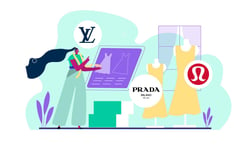In the world of online resale, brand names often steal the spotlight. But can you still turn a profit if the tag doesn’t say Free People or Levi’s? Absolutely!
Marketplaces are highly brand-driven, meaning unbranded clothes require extra effort to stand out. In the age of fast fashion and mass production, shoppers are more likely to trust known brands for consistent quality and fit.
That said, unbranded items can still sell quickly and profitably with the right strategies, especially when optimized with SEO-driven keywords, styled photography, and smart pricing.
This guide walks you through how to sell secondhand, unbranded clothes online for a profit, using modern tools like Vendoo to streamline your workflow and maximize your results.
Main Takeaways
- You can profitably sell unbranded clothes online by focusing on style, condition, and presentation instead of brand names.
- Shoppers prioritize aesthetics, affordability, and sustainability, making unbranded fashion a growing trend in 2025.
- Strong SEO is crucial: Use detailed, style-based keywords in your titles and descriptions, and trending hashtags.
- High-quality, styled photography builds trust and drives sales, especially when items are modeled or displayed against clean, neutral backgrounds.
- Avoid common mistakes like overpricing, vague titles, poor lighting, or skipping measurements—these reduce credibility and slow down sales.
- Vendoo is a game-changer, allowing you to enhance your listings, crosslist, edit, manage, and track listings across multiple marketplaces with ease.
Why Sell Secondhand Unbranded Clothes Online?
Selling unbranded clothing is one of the most accessible and underrated ways to build a profitable online resale business. Unbranded items present an appealing combination of low overhead, high flexibility, and ever-present demand.
One of the main advantages of selling unbranded clothing is the low sourcing cost. For minimal cost, you can often find stylish, unbranded pieces at most thrift stores and yard sales. This dramatically reduces your upfront investment and increases your margins, even if the final resale price lands between $10 and $30. Buyers aren’t necessarily looking for a name; they’re looking for value, fit, and style.
What makes unbranded fashion even more compelling in 2025 is the growing consumer appetite for sustainable options. In an era of mass-produced fast fashion, shoppers, especially Gen Z and Millennials, seek secondhand style out of principle. Thrifted and secondhand clothing offers an eco-friendly and budget-friendly solution that doesn’t compromise style or individuality.
Unlike selling luxury fashion, selling unbranded inventory doesn’t require a massive upfront investment. All you need is a phone, closet space, and a few basic tools.
👀 Did you know that tools like Vendoo can help you manage inventory, enhance listings, edit listing photos, and crosslist to multiple marketplaces in just a few clicks?
Steps to Selling Secondhand Unbranded Clothes Online
Selling unbranded clothes successfully requires a clear process. Since you’re not relying on brand recognition, every step, from sourcing to presentation to drafting, has to be intentional.
Let’s walk through the step-by-step process:
Step 1: Sourcing Unbranded Clothes to Sell
The key to profitable resale starts with smart sourcing. Sourcing refers to finding items to sell. Since unbranded clothes don’t command a premium on name alone, you need to be selective about what you buy and focus on trending style.
💡Tip: Keep up with what’s trending on TikTok, Instagram, fashion magazines, and even the marketplace newsfeeds.
Where to Find Unbranded Clothes
Most resellers start by selling things from their own closet or even friends and family. Beyond that, there are many low-cost, high-potential sources for unbranded inventory.

Boston thrifting pop-up, courtesy of @ErynnTheReseller
Unbranded clothing is accessible and you can find it anywhere:
- Thrift stores like Goodwill, Savers, Value Village, Plato’s Closet, and Salvation Army often have racks full of stylish pieces with no recognizable label.
- Garage and estate sales can be goldmines, especially for lower prices.
- Online marketplaces like Facebook Marketplace, OfferUp, and Buy Nothing groups frequently have clothing available for little or no cost.
💡Tip: Commercial thrift stores are often much pricier than local thrift stores that are privately owned or for the benefit of churches or charities.
Learn more creative ways to source in the article How to Source for Free or with a Low Budget.
What to Look for in Unbranded Clothes
Because unbranded clothes rely on style over name, you’re looking for items that visually stand out for their cut, color, pattern, style, fabric, texture, or aesthetic potential
Always choose pieces that are in excellent or like-new condition. Unbranded clothes won’t get the same forgiveness from buyers that designer items do, so every flaw counts. Look for:
- Trendy or timeless styles: straight leg jeans, fitted tops and body suits, wide-leg trousers, oversized blazers, and minimal basics.
- High-quality materials: linen, cotton, wool, silk, denim, and knits.
- Visual appeal: Does it look trendy?
👀 Keep an eye out for stylized pieces. Items that are western, punk, preppy, or clearly depict an aesthetic will lend themselves well to fashion-based shoppers with style keywords.
Step 2: Preparing Unbranded Clothes for Sale
Unbranded pieces require a bit more effort in presentation. Without the brand to rely on for exposure, you have to captivate buyers with the look and appeal to visually earn trust and stand out in a competitive feed.
Essential Tools and Supplies
You don’t need expensive equipment, but a few basics will make your listings look significantly more professional:
- Laundry detergent & stain remover: Always try to source items without stains or flaws, but you can also treat and mend items yourself. I recommend Grandma’s Magic Stain Remover!
- Steamer: Wrinkles kill visual appeal. Steam before every photo. The best steamers on the market are by Jiffy.
- Lint roller: Remove pet hair and fuzz for a clean finish.
- Fabric shaver: Remove pilling, fuzz, and snags with ease.
- A clear hanger: Clear hangers provide a clean, polished look
👀 Did you know that modeled photos sell better across all major marketplaces? If you’re willing to model or use a friend to model, your listings are more likely to sell!
How to Make Unbranded Clothes Stand Out
Your listing must create perceived value since the brand cannot. This means that your photographs and description are everything.
Start with strong photos, ideally on a clear hanger or a model, against a clean and lightly-colored background. Avoid floor shots or cluttered backgrounds that make items look less professional.

An example of modeling unbranded clothing by @FourLimes on Depop
In your title and description, highlight the style of the item. Instead of writing “cute top,” say “1980s geometric multicolor retro print blouse with red, yellow, and green stripes.” These descriptive, SEO-driven terms help your listing appear in search results and appeal to buyers looking for a specific aesthetic.
Take time to measure and include details like chest width, length, and inseam. Transparency reduces returns and builds trust, especially when there’s no brand to vouch for the fit.
Learn all about how to maximize fashion keywords in the article Reseller Fashion Core Aesthetics & Trending Style Hashtags in 2025.
Step 3: Selling Your Unbranded Clothes
Now it’s time to get your listings in front of buyers and convert that visibility into sales! Here is how to list and sell unbranded secondhand fashion:
Pricing Strategy
Unbranded secondhand clothing will not sell for the premiums of designer brands. Price your unbranded items based on style, condition, and market demand. Tops may fall in the $10–$18 range, dresses between $15–$30, and jackets or premium fabrics up to $50.
Model both a quick-sale price and a top-dollar price in our profit margin calculator so you can choose based on demand.
💡Tip: Use “comps” (comparable listings) to guide your pricing by seeing how other sellers are pricing similar items.
It’s okay for your starting price to be a bit higher than comparables to leave room to send and accept offers, but don’t overprice or your items will sit for a while.
🧠 Think about it: Buyers are paying for the product, not your prep. Despite all of the time, love, and care you put into your items, it does not make them objectively more valuable.
Reseller Listing Tips
Take your time with your listings, and optimize each listing field.
- Use at least 8 photos, but the more the better.
- Use high-quality photos that are clean, bright, and have a plain background.
- Use detailed titles and descriptions that describe the style, material, colors, patterns, occasion, formality, condition hems, and more.
- Use trending hashtags- as many as you can.
- Be sure to measure every item and include typed measurements in your descriptions.
- Do not skip any listing fields, not even the “optional” fields.
Use SEO for resellers to your advantage. Since marketplaces often deprioritize unbranded items in search, your titles must do the heavy lifting. Focus on style-based terms buyers might search for.
Common Mistakes to Avoid When Selling Unbranded Clothes
Unbranded clothes can be profitable, but avoid these common mistakes to sell faster and maximize profits:
Overpricing:
Just because you sourced it well doesn’t mean buyers will overpay. Keep pricing competitive. Remember that buyers also pay sales tax and shipping, so the $10 shirt will likely cost them closer to $20.
Weak Photography:
Unclear, dark, or wrinkled items don’t sell. Take the extra time to present well. Never take photos on the floor. Remember that shopping is a psychological process, and your images make an impression.
Ignoring Condition:
Even a small stain can turn off a buyer if it’s not disclosed. Try to avoid items with flaws, but if you list them, be sure to disclose in both photos and your description.
Using Vague Titles:
“Nice blouse” won’t be found by buyers in the search. “Sheer chiffon boho blouse with balloon sleeves” will.
The Best Online Marketplaces to Sell Unbranded Clothes
There are tons of peer-to-peer online marketplaces to sell clothes. Naturally, most favor branded inventory, but with the right keywords and photos, you can sell unbranded inventory everywhere!
Here are some of the best platforms to sell secondhand unbranded clothing and accessories:
Depop:
This marketplace is all about style and look, and it’s a great place for style-based, SEO-rich listings. On Depop, look is everything, and it’s all about the aesthetic and the trending hashtags you use in your description.
Vinted:
It's known for Gen Z bargain shoppers, where style is often as (if not more) important than brand. Vinted is good for basics, trendy fashion, and affordable style.
Poshmark:
The largest fashion-focused marketplace. Title and description are equally prioritized in the search engine, and unbranded items can perform well with the right keywords and photos.
Poshmark:
Casual user base seeking fashion on a budget. Buyers often prioritize the style and value over the brand.
Etsy:
Etsy is for vintage only, but if your unbranded fashion is at least 20 years old, Etsy is one of the best places to sell based on style over brand.
Maximize Sales with Vendoo’s Crosslisting Tools
If you’re serious about selling unbranded clothes, crosslisting is essential, and Vendoo is the best way to do it efficiently. Vendoo allows you to list an item once and publish it across multiple marketplaces with just a few clicks.
This not only increases your exposure but also helps you reach different types of buyers. If something isn’t selling on Depop, it might sell quickly on Mercari or Poshmark. Vendoo makes it easy to test different platforms and pricing strategies.
It also offers tools to track inventory, remove sold listings automatically, bulk editing, photo editing, sending offers, sharing your items, relisting, and more!
Vendoo is a Seller’s Best Friend; it’s the ultimate tool for sellers who want to save time and grow profits!
Brand Doesn’t Matter, Style is Everything
If you know how to style, describe, and price them, unbranded secondhand clothing can be a profitable source of resale income. It’s not about the logo, it’s about the strategy. Buyers care about how a piece looks, feels, and fits, and your job as a seller is to showcase that in the most compelling way possible.
By following the steps in this guide and using tools like Vendoo to streamline your work, you’ll gain a competitive edge in even the most brand-driven marketplaces.
Do you focus on style as much as brand? Tell us your strategy below! 👇🏽
Selling Secondhand Unbranded Clothing FAQ
What are the best platforms to sell unbranded clothes?
Unbranded clothing can perform well across multiple online marketplaces, including but not limited to Depop, Vinted, Poshmark, eBay, Mercari, Etsy, and more! Crosslist to all major marketplaces in seconds with Vendoo!
How long does it take to sell unbranded clothes?
Speed of sale depends on factors like demand, style relevance, seasonality, and exposure. Crosslisting and staying active on platforms (sending offers, relisting, etc.) can help items move faster.
What should I include in my listings to help unbranded items sell?
Since the brand can’t carry the listing, you must create value through detail and presentation. Every unbranded listing should include SEO-rich titles and descriptions, trending hashtags, high-quality photos, measurements, condition notes, a competitive price, and style-based descriptive words.
What are the top secondhand clothing trends for 2025?
- Minimalist silhouettes and quiet luxury: think high-quality basics, monochrome looks, and tailored fits
- Straight and Wide Leg bottoms
- Y2K revival: metallics, low-rise jeans, halter tops, and butterfly motifs remain strong
- Cottagecore and romantic styles: ruffles, lace, floral prints, and vintage prairie dresses
- Elevated loungewear: neutral-toned sets, oversized sweaters, and joggers.
- Schoolgirl and “Classic Prep” like pleated skirts, polos, cardigans, and loafers—especially in dark academia tones
- Western and utility-inspired: fringe, denim, workwear jackets, and cargo pants.
How do I know what keywords to use for unbranded listings?
The best way to find effective keywords is to think like your buyer. Ask yourself: “What would someone type to find this item?” Use style keywords, aesthetic references, and enough adjectives that you can vividly picture the item in your head just by reading the description. These words help your items to appear in relevant searches.
Should I include measurements in my listings?
Yes, always include measurements, especially for unbranded clothes. Without a brand or size guide, buyers rely entirely on your description to judge fit. At minimum, include: chest, waist, hips, total length, inseam, and sleeve length, as applicable.
How can Vendoo help me sell unbranded clothes?
Vendoo is the ultimate tool for scaling your resale business with tools and features to help you save time and maximize profits.
Vendoo allows you to:
- Crosslist to 11+ marketplaces in just a few clicks
- Edit photos, titles, and descriptions across platforms from one dashboard
- Relist, delist, and send offers automatically
- Track inventory and sales analytics
- Send offers across all marketplaces
- Avoid duplicate sales with instant delisting when an item sells







